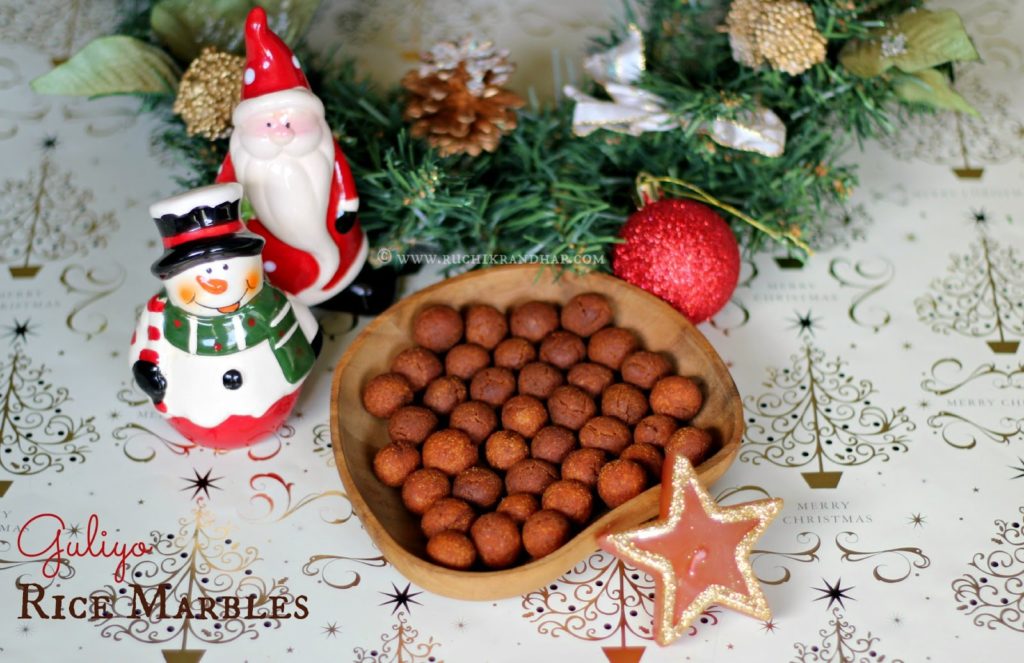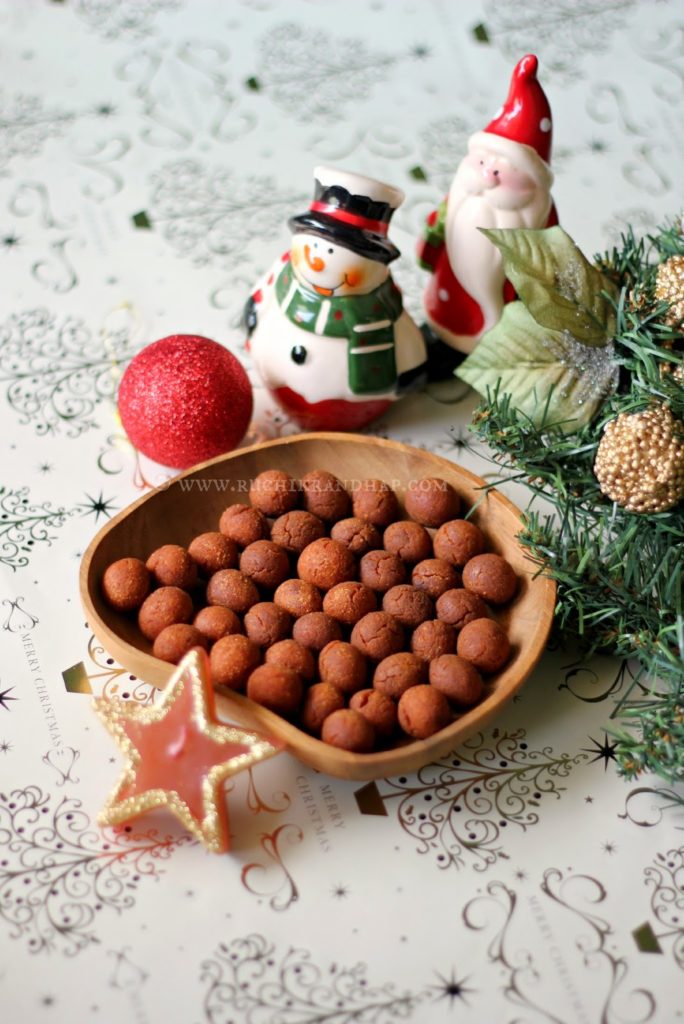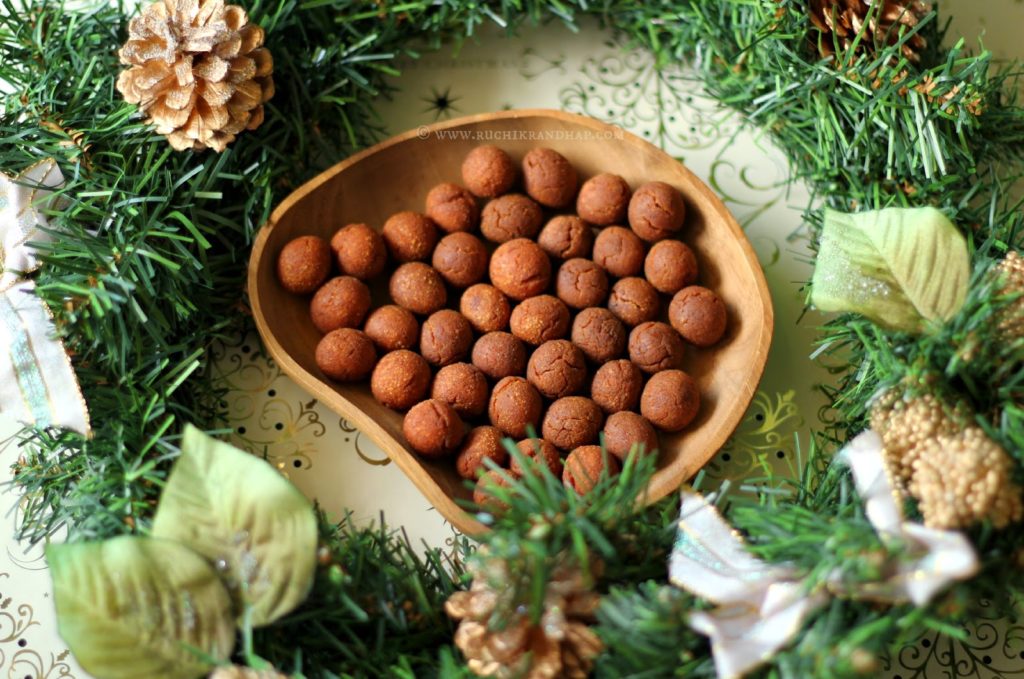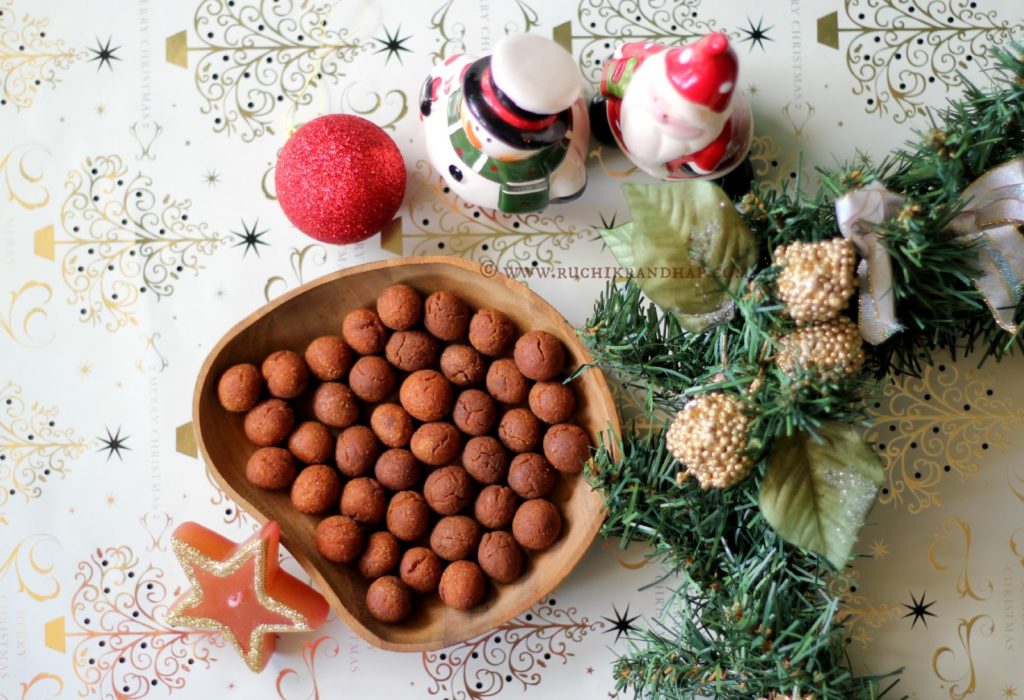Christmas is exactly a week away and I have so many things to complete! While browsing through my list of Christmas recipes I realised that I hadn’t posted the Gulio recipe yet. It is a quintessential Mangalorean Kuswar item although it is slowly losing out to other popular items on the goodie platter. To those new here, ‘Kuswar’ is a collective term for Christmas goodies prepared in Mangalorean Catholic households and includes sweets as well as savouries – mostly deep fried.
A few years ago I had prepared the gulio and photographed them too but when I sat down to write the recipe I realised that I had misplaced the piece of paper I had noted it on. Since that week I had prepared several Kuswar items I couldn’t remember the proportions and decided to try them again before posting the recipe. Days passed by and I simply forgot about it. Today I realised that it was high time I prepared and posted this recipe and with this my Kuswar collection is almost complete.
Kuswar is an ever growing collection of goodies I would say. Whenever I visit Mangalore during Christmas I get to eat new things being included in the traditional platter and most times the gulio are missing. When asked, people say that since nobody really likes to eat these hard marbles they excluded them. Sad, really. I always loved gulio as they had a bite and crunch and a milk sweetness that came from jaggery – something that I really enjoyed during my childhood.
If you have skipped the gulio from your kuswar platter it is time to put it back on! Let our younger generation test the strength of their teeth – and don’t test them with your dentures on! These lovely marbles of rice give you an ‘earth-shattering’ experience! If they are fried correctly they turn out EXTREMELY CRUNCHY! So try them!!
Guliyo ~ Deep Fried Rice Marbles
Prep time: 5 hours (soaking time) + 25 mins | Yield: approx 120 rice marbles
Ingredients:
- 125 grams (2/3rd cup) boiled rice * see notes
- 125 grams (2/3rd cup) raw rice * see notes
- 125 grams (1/2 cup) jaggery, powdered
- 1/2 cup thick coconut milk * see notes
- pinch of salt
- oil for deep frying
Method:
1. Wash and soak the two types of rice in plenty of water for at least 5-6 hours. Drain off the water completely, preferably on a colander or sieve.
2. Grind the washed & drained rice, jaggery, salt to taste using approximately 1/4 cup of the coconut milk until you get a fine, smooth, thick batter. Don’t add any water, instead add the coconut milk as required. Reserve the remaining coconut milk.
3. If you have ground it in the traditional way skip this step but if the batter has been ground in a mixer grinder then chances are that the batter is loose/liquidy unlike when ground in a traditional stone mortar and pestle so we need to remove the excess liquid/moisture by giving it a light steam. Place the batter in on a steel plate lined with a muslin cloth and when the water in the idli steamer/thondor comes to a rolling boil place the plate inside it. Cover the steamer and let the batter steam for 4-5 minutes – not too long or the batter will turn hard.
4. Remove the batter out and when slightly cooled knead it into a smooth ball. To aid kneading dip your fingertips in the reserved coconut milk – only if required and knead the ball.
5. Pinch out lemon sized balls from the dough and cover the rest with a damp, clean kitchen towel so that the dough doesn’t dry out quicky (which will make it hard to get
6. Roll the lemon sized balls into a thin rope and pinch out small marble sized portions out of it. Roll each marble into a tight, smooth ball without any cracks on the surface. Continue till all the dough is finished up.
7. Heat oil for deep frying in a wok/kadhai – larger the pan faster you will finish your work. Heat the oil on a medium high heat – not very high or very low. If the oil is too hot the marbles will burn quickly on the outside and remain under cooked inside. If the oil is not hot enough the marbles will remain uncooked and absorb oil. To test the readiness of the oil drop a small piece of dough into the oil and if it takes 2-3 seconds to come to the surface with tiny bubbles all around it, the oil is ready.
8. When the oil is ready gently slide in the rice marbles and let them fry till brown evenly. If your oil is at the right temperature the process of browning could take a few minutes – be patient and try not to increase the heat to a high. Once they turn a colour into chocolate brown (not very dark) remove them with a slotted spoon onto a plate lined with an absorbent kitchen tissue.
9. Allow marbles to cool completely before storing in an airtight container. They keep very well for many days. When perfectly fried and completely cooled the rice marbles will be very crisp and crunchy – not chewy.
5. Pinch out lemon sized balls from the dough and cover the rest with a damp, clean kitchen towel so that the dough doesn’t dry out quicky (which will make it hard to get
6. Roll the lemon sized balls into a thin rope and pinch out small marble sized portions out of it. Roll each marble into a tight, smooth ball without any cracks on the surface. Continue till all the dough is finished up.
7. Heat oil for deep frying in a wok/kadhai – larger the pan faster you will finish your work. Heat the oil on a medium high heat – not very high or very low. If the oil is too hot the marbles will burn quickly on the outside and remain under cooked inside. If the oil is not hot enough the marbles will remain uncooked and absorb oil. To test the readiness of the oil drop a small piece of dough into the oil and if it takes 2-3 seconds to come to the surface with tiny bubbles all around it, the oil is ready.
8. When the oil is ready gently slide in the rice marbles and let them fry till brown evenly. If your oil is at the right temperature the process of browning could take a few minutes – be patient and try not to increase the heat to a high. Once they turn a colour into chocolate brown (not very dark) remove them with a slotted spoon onto a plate lined with an absorbent kitchen tissue.
9. Allow marbles to cool completely before storing in an airtight container. They keep very well for many days. When perfectly fried and completely cooled the rice marbles will be very crisp and crunchy – not chewy.
Notes:
Boiled rice is a variety of rice where the paddy is boiled in large drums of water right after it is harvested from the fields. Not to be confused with ‘cooked’ rice. Raw rice is derived from paddy that is husked without the boiling process.
To make 1/2 cup coconut milk from coconut milk powder (I use Maggi) add 4 tablespoons of it to approx 1/4 cup (or a little less than 1/2 cup) warm water and mix well to remove any lumps.
If you steam the dough too much it could dry up fast and result in marbles that have cracks on them. Try to knead the dough with the coconut milk before you prepare the marbles.
To make 1/2 cup coconut milk from coconut milk powder (I use Maggi) add 4 tablespoons of it to approx 1/4 cup (or a little less than 1/2 cup) warm water and mix well to remove any lumps.
If you steam the dough too much it could dry up fast and result in marbles that have cracks on them. Try to knead the dough with the coconut milk before you prepare the marbles.




yummmy ..i love this sweet
Those rice balls look so sinful..we make a similar one for other festivals as well!..very nice..
@Vanamala Hebbar: Thanks so much!
@Srivalli: Glad to know that! Our cuisines are so similar isnt it?
My mom learned this recipe from a Mangalorean friend and we called it marbles. I never knew its real name. You made me nostalgic.We used to carry it to school for xmas party.
Hi Shireen,
I followed the Guliyo recipe and I must say it came out perfect and crispy. However, the next day all the guliyo became soft despite keeping in air tight container. Can’t figure out what went wrong. Any suggestions to rectify the sogginess.
Hi Sharlet, Glad to hear that the gulio turned out crispy. Not sure why they turned out soft as I’ve never had that problem! you could keep a slice of bread in the container as it will absorb all the moisture. Alternatively do try microwaving them for 30 seconds and cool before eating. This could also help
I made guliyo but it has become a bit soft. Did as u have explained. But taste is come nice. It was made in grinder.
Did you store the guliyo in an airtight box after they were made?